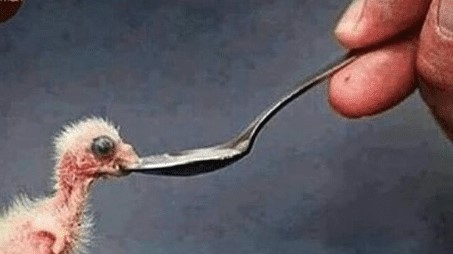While doing research on the internet, okay, while trying to avoid work, distracting myself with cute animals, I came across this little guy right here.
Yes, the image of a baby bird, being spoon-fed, can make even the hardest of hearts melt I bit (at least, I hope it does).
Attached to the image was this statement: “You will never regret being kind.”
I started thinking about that concept. Like many abuse survivors out there, I’ve been exploited and taken advantage of, simply because, many times, I was trying to be kind. Add to that reality, the message pressure of “Be nice” we so often hear, especially as children, and the whole expression of humanity becomes muddy.
We can ask ourselves, “Am I being kind?” “Am I being nice?”
What’s the difference between the two? Which one should I choose?
The baby bird image simplifies the issue. So, let’s return to that little budgie.
First, this little guy is helpless, practically bald, as his pink skin barely has enough “peach fuzz” to cover his body. He must be freezing. Someone, please get him a sweater.
We see the vulnerability of this creature, perhaps, eliciting our innate caregiving response. So, the picture appears quiet, calm and gentle. There is no force feeding. A spoon is gently presented to the helpless, hungry guy. I’m quite certain music from ACDC was also not playing in the background (nothing against the band, ACDC).
I mention this to illustrate how, for the greater good, meaning, the survival and well-being of this baby bird, all focus goes to taking care of him. There is no fanfare, no attention seeking.
Perhaps, that is the essence of kindness.
Now, let’s contrast that with “Being Nice.”
There is a difference.
For, in this instance, we go back to our baby bird and the “spoon feeder.” Here, this person declares, “I’m a nice person.”
But it’s not quite that simple.
The image in this scenario would probably be dramatically different. The focus would be changed.
Perhaps, this picture would be all hand, all spoon, with absolutely no emphasis on the baby bird. Maybe, you’d see a beak in the photo, at most.
Maybe.
This “nice” approach may be that way, because the nice agenda dictates it be a birdfeeder spoon photo op. It has nothing to do with keeping the helpless being alive. It has, instead, everything to do with the perception surrounding the spoon feeder.
Isn’t he/she such a great person? Just look at what they’re doing!
Yes, “Nice” has an agenda and a superiority to it. It can be self-directed, or it can be externally achieved, through other people, outside of the situation.
The kind person, however, says nothing. There’s no need to be validated with “How great thou art.” There’s no need for accolades. The spoon feeder is too busy spoon feeding the baby bird, to pay attention to what everyone else is saying.
In this instance, perhaps, this photo would have the feeder make every attempt to not be in the picture. There would be no identifying characteristics. It’s more than enough to see the tips of his/her fingers.
Kind just is.
But, again, Nice is concerned with appearances.
There is the glory of the photo op. If a nice deed happens, and it is not caught on camera, does it exist?
Who knows? Without a camera present, the person might be captured tormenting the bird.
Kind doesn’t think that way.
Kind doesn’t entertain manipulation and abuse. Nice, perhaps, does.
Kind is concerned with the kind act they wish to perform.
It’s a Deliberate Decision.
The difference between Kind and Nice doesn’t need to be confusing. It can come down to decision making. And we all engage in decision making.
Kind makes a decision to be Kind. Nice makes a decision to be Nice.
It’s intentional, whether we know it or not. What drives us? What compels us? And how will we respond to that honest answer?
How will we feed that baby bird?
Copyright © 2020 by Sheryle Cruse






Read 0 comments and reply